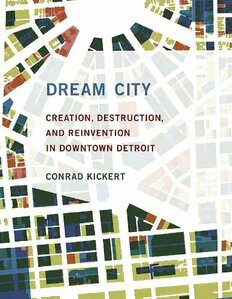
Dream City: Creation, Destruction, and Reinvention in Downtown Detroit PDF
Preview Dream City: Creation, Destruction, and Reinvention in Downtown Detroit
DREAM CITY DREAM CITY CREATION, DESTRUCTION, AND REINVENTION IN DOWNTOWN DETROIT CONRAD KICKERT THE MIT PRESS CAMBRIDGE, MASSACHUSETTS LONDON, ENGLAND © 2019 Massachusetts Institute of Technology All rights reserved. No part of this book may be reproduced in any form by any electronic or mechanical means (including photocopying, recording, or information storage and retrieval) without permission in writing from the publisher. Illustrations in this book were funded in part or in whole by a grant from the SAH/Mellon Author Awards of the Society of Architectural Historians. Color reproduction of this book was supported by the University of Cincinnati, School of Planning, Orville Simpson II Endowment Fund. school of planning This book was set in Minion and Trade Gothic by The MIT Press. Printed and bound in the United States of America. Library of Congress Cataloging-in-Publication Data Names: Kickert, Conrad, author. Title: Dream city : creation, destruction, and reinvention in downtown Detroit / Conrad Kickert. Description: Cambridge, MA : The MIT Press, 2018. | Includes bibliographical references and index. Identifiers: LCCN 2018019052 | ISBN 9780262039345 (hardcover : alk. paper) Subjects: LCSH: Central business districts--Michigan--Detroit--History. | Detroit (Mich.)--History. | Detroit (Mich.)--Economic conditions | Urban renewal--Michigan--Detroit--History. Classification: LCC F574.D46 D665 2018 | DDC 977.4/34--dc23 LC record available at https://lccn.loc.gov/2018019052 10 9 8 7 6 5 4 3 2 1 CONTENTS Preface viii Introduction 1 I SPRING 1 From Outpost to Downtown: 1805–1884 8 2 Going Up and Out: 1884–1911 32 II SUMMER 3 Downtown in Transition: 1911–1921 52 4 Growing Pains: 1921–1929 76 III FALL 5 Early Erosion: 1929–1937 106 6 Battling Blight: 1937–1951 120 7 The City of Tomorrow: 1951–1961 146 8 Boiling Point: 1961–1967 172 IV WINTER 9 The End of Urban Renewal: 1967–1977 188 10 Renaissance among Ruins: 1977–1988 208 11 The Leisure City: 1988–2001 230 12 A Roaring End: 2001–2011 248 13 A New Beginning: The Past as Future 256 14 Conclusion 268 Notes 288 Index 432 PREFACE We Europeans change within changeless cities, and our houses and neighborhoods outlive us; American cities change faster than their inhabitants do, and it is the inhabitants who outlive the cities. … For us a city is, above all, a past; for them it is mainly a future; what they like in the city is everything it has not yet become and everything it can be. Jean-Paul Sartre1 [Missing P_STYLE: Image] Figure This is a book about an anomaly. In a city known for discarding anything it deems obsolete, from last year’s car model to entire neighborhoods, downtown Detroit has always stood out as an unavoidable reminder of the past. Downtown is different—it’s slower. Perhaps that’s why it piqued my fascination as a young European urbanist over a decade ago. Downtown Detroit challenged my Dutch upbringing that hinged on view- ing the past as an asset and public authority as benevolent and inevitable. Downtown Detroit’s tangible failure to embrace the past and the public became the starting point of the journey that has led to this book—a journey that would soon challenge my notion of the American urban condition. This work would not have been possible without the support of the countless archi- vists that hold the key to Detroit’s past, most notably the staff at the Burton Historical Collection at the Detroit Public Library, the Walter P. Reuther Library at Wayne State University, the University of Michigan Clark and William L. Clements Libraries, and the United States Library of Congress. I would also like to thank my dissertation com- mittee members Robert Fishman, Linda Groat, June M. Thomas, and Henco Bekkering for helping me lay the groundwork for this book. In Detroit, I am very grateful to Keith Harder Cavazos, Paul Szewczyk, Dan Austin, Mark Nickita, Dorian Moore, Michael Hauser, and John Gallagher for their input. I would like to thank my colleagues at the University of Cincinnati for giving me feedback, space, and resources to pull this off. And I would like to thank my graduate assistants for helping with graphics and man- agement. Last but not least, I would like to thank my family and friends for their moral support, most notably my parents for encouraging me to keep asking questions, and Kelly Gregg for tolerating my spiritual absence in writing this book.
